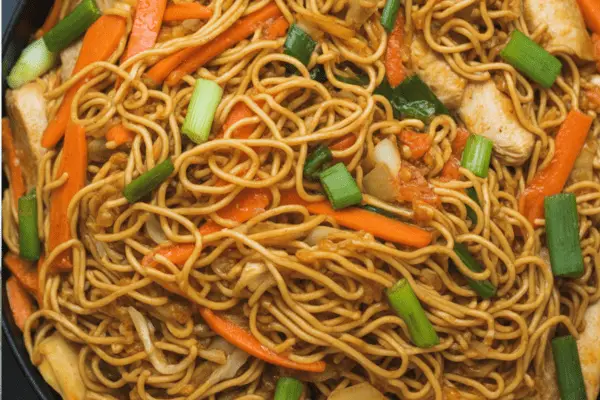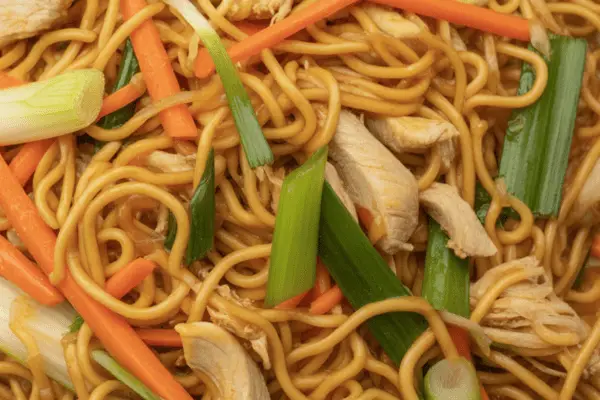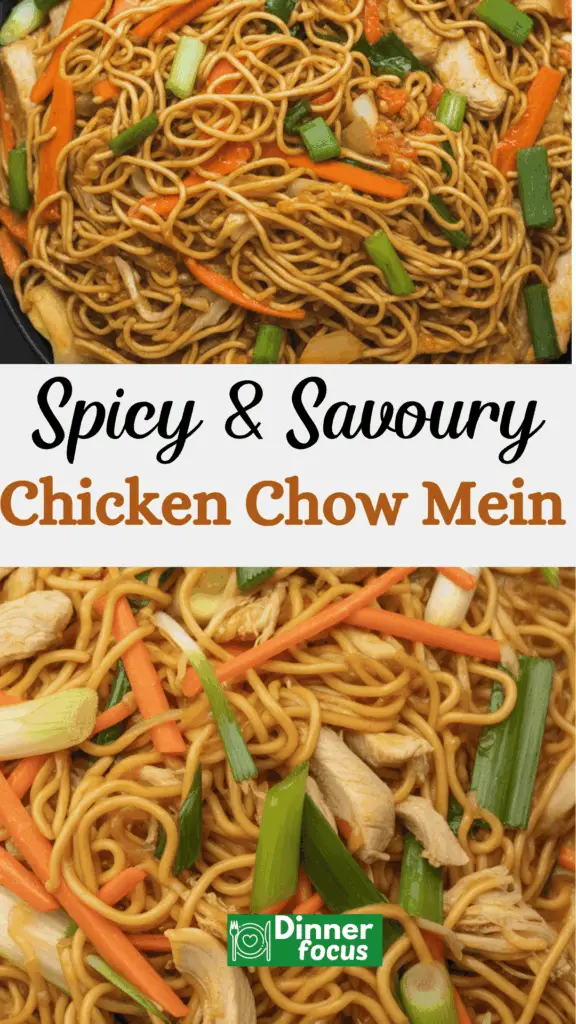I’ve got to tell you, this Chicken Chow Mein is one of my absolute favourite ways to skip the takeout bill and make something amazing at home. It’s a one-pan wonder with juicy chicken, loads of crisp-tender veggies, chewy noodles, and that glossy, savory sauce that makes you want to lick the pan clean.

I’ve been making this for years—especially on busy weeknights when I want something fast but still crave that restaurant-style comfort. And let’s be honest, it’s way fresher and lighter than the takeaway version.
What Makes This Chow Mein Special
When you stir-fry chow mein at home, you’re in full control. I love the seared noodles—those chewy, slightly crispy edges are just too good. And that sauce? It’s the reason you end up eating straight from the wok with a fork.
For me, this is one of those meals I make when I don’t want to wash a ton of dishes. Everything happens in one big pan or wok, and dinner’s on the table in about 30 minutes.
My kids even eat the veggies without complaining, which tells you a lot about how good that sauce is.

Let’s Talk Ingredients (What I Use and Why)
Noodles:
I usually buy refrigerated chow mein noodles when I can get them—they’re already cooked, so you just toss them in. They get those gorgeous seared bits when pan-fried. If I can’t find them, the dried ones in the Asian aisle work too—just boil them first.
Pro tip: If you’re in India like me and can’t always find “chow mein” labeled noodles, even regular Hakka noodles do the trick.
Veggies:
I love using thinly sliced carrots, shredded cabbage, bean sprouts, and green onions. But honestly, this is a “fridge cleanout” dream. I’ve tossed in everything from bell peppers to spinach.
If you’ve got leftover roasted broccoli? In it goes. Half a bell pepper looking sad? Slice it thin and toss it in.
Chicken:
I usually use boneless chicken breast or thighs. Thighs stay juicier if you’re prone to overcooking, but breast is what I usually have on hand. Sometimes I switch it up with shrimp on special occasions.
Hosting vegetarians? I’ve set some noodles aside and tossed them with baked tofu cubes in the same sauce. Everyone’s happy.

My Favourite Homemade Chow Mein Sauce
This sauce is the secret. It’s salty, a little sweet, and has that unmistakable takeaway-style gloss thanks to cornstarch.
Here’s what I mix up in a small bowl before I even heat the pan:
- Soy sauce for saltiness
- Oyster sauce for deep umami
- Sesame oil for nutty aroma
- Sugar for balance
- Cornstarch to thicken everything nicely
- A splash of chicken broth to bring it together
You don’t need any bottled “chow mein sauce” from the store. This is cheaper, fresher, and you can tweak it to taste. I sometimes add a bit of chili sauce if I want it spicy.
How I Make It in My Kitchen
This is my real-life weeknight workflow.
- Make the sauce: Stir everything in a bowl and set aside.
- Cook the noodles: Boil them if they’re dried. If they’re fresh or pre-cooked, I give them a quick rinse to separate.
- Brown the chicken: A splash of oil in a hot wok or big pan, toss in sliced chicken, and sear until golden. Take it out.
- Veggies time: Add a bit more oil if needed, toss in carrots, cabbage, garlic. I like them tender-crisp, not mushy.
- Bring it together: Add the chicken back, then the noodles. Pour in that sauce and watch it coat everything beautifully. I toss it for about 2 minutes until the noodles soak it all up.
- Finish: Top with green onions, remove from heat, and serve immediately.
Sometimes I serve it straight from the wok in the middle of the table. Less plating, more eating.
Why I Keep Making This Again and Again
This dish has become such a regular at my place because it solves so many dinner problems.
Busy day? Done in half an hour.
Hungry kids? They love it.
Need to use up veg? Perfect.
Craving takeout but watching the budget? This costs a fraction.
I even pack leftovers for lunch the next day, and it reheats really well in a hot pan with a splash of water or broth.
Tips from My Own Kitchen
- Don’t crowd the pan too much. I use my widest wok or kadai so the noodles fry a little instead of steaming.
- Prep everything before turning on the stove. Chow mein cooks fast and you won’t have time to chop mid-way.
- Cut chicken into thin strips so it cooks quickly and stays tender.
- If you like heat, add sliced fresh chili or chili sauce to the sauce.
I’ve made this on gas stoves, induction cooktops—even on a camping burner once. It’s very forgiving.
Storing and Reheating Leftovers
I always make extra because it keeps well in the fridge for about 2 days. I store it in an airtight box.
To reheat, I toss it in a pan with a splash of water or broth to loosen it up. Microwave works in a pinch but I prefer the pan for better texture.
If you’re planning ahead for busy days, you can even pre-chop the veggies and store them in a container, making dinner even faster.
Make It Your Own
Don’t get too hung up on “authenticity.” The best part of homemade chow mein is making it work for you.
Swap the chicken for shrimp, beef, or tofu. Use whatever veg you have. Play with the sauce ratios to your liking.
This is the kind of recipe that lives in your back pocket and saves you on those “what’s for dinner” nights.
Chicken Chow Mein

There's just something so comforting about a big skillet of saucy noodles tossed with tender chicken and crisp veggies.
Ingredients
- 12 oz chow mein noodles (uncooked)
- 1 lb boneless, skinless chicken breast
- 2 cups shredded cabbage
- 1 large carrot, julienned
- 2 garlic cloves, minced
- 1/2 bunch green onions, chopped
- 3 tablespoons neutral oil (like vegetable or canola)
For the sauce:
- 6 tablespoons oyster sauce
- 3 tablespoons light sesame oil (not toasted)
- 3 tablespoons low sodium soy sauce
- 1/2 cup chicken broth
- 1 tablespoon cornstarch
- 1 tablespoon granulated sugar
Instructions
- Start with the sauce – In a small bowl, whisk together the oyster sauce, soy sauce, sesame oil, chicken broth, sugar, and cornstarch until smooth. Set this aside—it’s going to bring everything together later.
- Boil the noodles – Cook the chow mein noodles according to the package directions. Once done, rinse them under cold water to stop the cooking process and keep them from sticking together. Drain and set aside.
- Sear the chicken – Heat the oil in a large skillet or wok over medium-high heat. Slice the chicken into thin strips and cook until golden and just cooked through. Remove the chicken from the pan and keep it nearby.
- Sauté the vegetables – In the same skillet, add the carrots and cabbage along with the garlic. Stir-fry until the vegetables are just tender and the cabbage starts to soften.
- Bring it all together – Return the cooked chicken to the pan, followed by the noodles. Pour the prepared sauce over the top and toss everything together until it’s evenly coated. Let it cook for another couple of minutes so the sauce thickens slightly and clings to the noodles.
- Finish with green onions – Sprinkle with freshly chopped green onions just before serving for a fresh pop of flavor.
Nutrition Information
Yield
8Serving Size
1Amount Per Serving Calories 422Total Fat 19gSaturated Fat 3gTrans Fat 0gUnsaturated Fat 15gCholesterol 49mgSodium 1176mgCarbohydrates 38gFiber 3gSugar 5gProtein 22g
Dinnerfocus.com, occasionally offers nutritional information for recipes contained on this site. This information is provided as a courtesy and is an estimate only. This information comes from online calculators. Although allchickenrecipes.com attempts to provide accurate nutritional information, these figures are only estimates.
Final Words from My Kitchen
If you’ve never tried making your own chow mein at home, I promise it’s easier than you think. You get that satisfying takeaway-style flavor with fresher ingredients, less oil, and a smaller price tag.
Pull out your biggest pan, get your ingredients prepped, and give it a go. And if you do, I’d love to know how it turned out for you.
Try other recipes:
